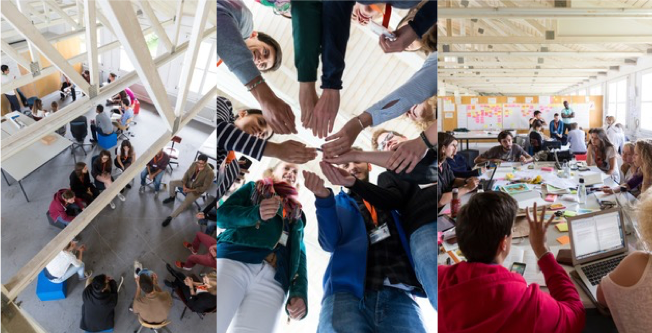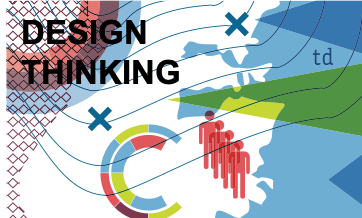Design thinking
An iterative methodology for (re)framing problems and co-creating implementable solutions using visual thinking and prototyping.
Pearce B 2020. Design Thinking. td-net toolbox profile (11). Swiss Academies of Arts and Sciences: td-net toolbox for co-producing knowledge. www.transdisciplinarity.ch/toolbox. doi.org/10.5281/zenodo.3717021
| What is design thinking? | Design thinking is a collaborative problem-solving strategy. Design thinking: a) connects the needs of people involved in the problem to researchers’/experts’ observations of the problem; b) focuses on creating innovative ways of looking at the problem; c) embraces visualization, storytelling, and experimentation through building and testing prototypes. |
Why should it be applied? | In the context of research, design thinking is for: (1) co-designing research designs with stakeholders, and (2) co-designing implementation strategies of research outcomes. The approach is based on the assumption that framing problems in new ways can lead to more implementable and innovative solutions. In the context of education, design thinking can be used to build collaborative skills of students to tackle complex problems in interdisciplinary settings. |
When should it be applied? | Design thinking is most effective before a problem has been defined. In later stages, it is a prerequisite that there is openness to changing an already existing problem definition. |

How does it work? | The five-step methodology of design thinking is embedded in a human-centered mindset. The steps are group processes accompanied by a facilitator. The group composition and level of stakeholder involvement in each step may vary and should be in line with the main purpose of the project (e.g. education vs. implementation of a product/solution). 1) Empathize – The group gathers information about the problem situation and collects insights on a particular theme. These insights are specific in time and place, usually pinpoint a contradiction, and explain why or how things work. Group members are encouraged to immerse themselves in the physical context of where the problem-situation is occurring. This can be done through observation, interviews, group discussions, workshops and a wide variety of other approaches.Furthermore, insights can be derived from literature reviews, experiment, or any other analytical process. 2) Define – The group identifies and agrees upon the insights that are most surprising or meaningful to its members. If the group members cannot come to a consensus about the most relevant insights, a more systematic approach can be taken: Group members can make connections between or cluster insights (for example, insights that are shared by the same stakeholders, institutions, etc). On the basis of the selected insights, group members create point-of-view problem statements. These statements are made up of three parts: {Stakeholder X} needs/is lacking {specific need or lack} because/due to/although... {insight}. Multiple problem statements can be created from one insight by connecting the insights to different stakeholders. 3) Ideate – Using each problem statement as a focus, the group brainstorms potential solutions. Each group member takes a piece of paper and writes down the first thing that comes to his or her mind in relation to the problem; Then, one person starts and says his/her idea out loud, and lays the piece of paper in the middle of the table. The next group member builds on this idea or just says a new idea and lays this new idea on top. There is no wrong way to brainstorm, as long as to defer judgment is kept in mind. Ideas should not be debated at this stage. The goal is to capture as many different ideas as possible rather than argue their merits. At the end of the brainstorming, there should be a large pile of ideas. In a scientific setting, it may be beneficial at this point to develop a list of criteria for the type of solution needed and choose ideas according to these criteria. 4) Prototype – Group members transform the chosen ideas into physically concrete objects or conceptual papers. These prototypes can be made with craft materials or whatever is available: clay, pipe cleaners, Lego pieces, cardboard, rubber bands. The goal is to make the ideas more concrete and to identify blind spots in the ideas. 5) Test – Prototypes are presented to other stakeholders as soon as possible. The input of those who might be affected by the implementation of the idea is of advantage. The goal is to incorporate this feedback early in the development of an idea so that it can be improved rapidly. |
| How are thought-styles bridged? | Thought-styles are bridged when group members jointly formulate and agree on problem statements before a solution can be designed. Agreement or discussion of different understandings of the problem is therefore embedded into the methodology. |
| What’s the output/outcome? | A prototype of a product, service, strategy or concept that addresses a specific problem linked to explicit needs of stakeholders. |
| Who participates in what role? | A facilitator is needed to lead the process. Experience in design thinking is ideal, but there are resources available online that may be helpful for those who are trying it for the first time. No prior experience is needed to participate in design thinking. Be aware that the group composition may affect the acceptance and usability of the results. |
| What do I need to prepare? | Group tables, markers, small pieces of paper for brainstorming, flip chart paper, white board/black board/wall surfaces for each group, material for prototyping (see above). Design thinking is dependent on a safe environment in which creativity and risk taking is allowed. Be aware that the most difficult aspect of this method is identifying good insights. The insights should explain the “why” or “how” of a system that is rooted in a specific context. These insights often come from personal experiences, stories, and engagement. In this way, insights are often a combination of prior knowledge, new data, and intuition, rather than data points. |
| When not to use the method? | Design thinking should not be used when the problem is already specified and the problem definition is not allowed to be changed. The effectiveness of design thinking might be affected by the political and social context in which it is carried out. In societies where bottom-up action is not encouraged, this particular approach to problem solving might seem risky and fruitless. |


